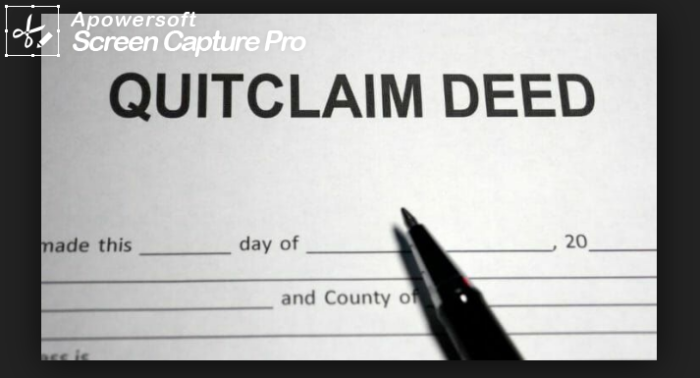A quitclaim deed it’s used to transfer the ownership of property not including any warranties.
In the document is stated the person giving up the ownership of the property is the grantor, and the person getting it is the grantee.
Likewise, it should include the legal description of the asset being transferred, which includes the length and direction of boundary lines.
You can follow some easy steps to obtain your quitclaim deed:
Make a draft of your quitclaim deed

Look for an attorney or title company to assist you. In some cases, making a quitclaim deed can be confusing and difficult.
Therefore, is going to be easier if you have the help of a lawyer or a firm to guide you with the terminology.
In order to find the adequate attorney, you can call the state bar association for recommendations.
Get hold of forms or templates for a quitclaim deed
Online sometimes you can find some form or template in accordance with your state law, if not, go
to your county’s land records office to check.
- More specifically the office is probably called the Recorder of Deeds
- Also, you can check the county court website
Check this links https://eforms.com/deeds/quit-claim/
https://www.deeds.com/quit-claim-deed/
Name the person who wrote the deed
At the top of the document, it must appear a blank space to identify the person who makes the deed, fill it with your name.
Identify the person receiving
Also, t the quitclaim deed form is going to be a space for you to identify who is going to be granted with the deed (grantee).
In addition, you have to write the address of the person because once the deed is filed, the grantee will be receiving:
- The copy of the deed
- The land records
- The future taxes generated by the property
- Name the parties on the quitclaim deed
On the document it must be identified the grantor and the grantee, meaning the person transferring and the person receiving the property, along with their current addresses.
You can get a quitclaim deed from the title company that will show the former legal owner, and who granted it to them.
Furthermore, you can request a title search on the property to know if the grantor is the legal owner and discover if the piece of land is owned by several persons.
And if the entire property is being transferred or partially, then all owners need to transfer their ownership.
Present substantial information

On the document of the deed, there must be vital information regarding the property and the parts involved.
Some information that it needs to be added are:
- Date of the transfer
- Specify if you paid for the property and how much was it
- If you didn’t pay you to have to put at least a dollar because the law requires it in that way
Note an example: After you list the name of the grantor and the amount for the transfer, you should use these words:
Hereby by sell, release, remise, quitclaim and convey onto (name of the grantee) followed by the county and state of residence.
Provide a legal description of the property
You can find this requirement on the current deed. Requested at the county land records office.
In some cases, quitclaim deeds will involve a parcel number or the meet’s and bounds description and even both.
- First of all, identify the county and state where the land is located.
- Make sure you verify more than one legal description of the property and corroborate you have entered it correctly.
In case of a mistake, you could face a boundary dispute.
Leave space for the signatures
Usually, the grantor must sign at the bottom of the quitclaim deed.
Nevertheless, there are some states that in addition require that the receiver or grantee and witnesses sign the quitclaim deed.
Therefore, you should take in signature lines and some other lines for the date.
Mind the notary
Take into mind that the document has to have a notary block already type in when you are using a form or template, but if you are writing it by yourself, have the regard of including a line for the signature of the notary, especially if it is at the bottom.
Execute the quitclaim deed

You will need a notary to legalize your quitclaim deed; you can get in touch with one at the courthouse, the land records office, or at most large banks.
Remind yourself to bring your personal identification, such as a valid state-issued ID or passport and take in the regard that most likely you will have to pay a fee for the notary services.
Take care of the other paperwork
It mostly depends on your location, but you might need to complete other forms prior to filing the deed.
Make inquiries with the clerk at the land records office for all forms you are going to need.
For example, in California, there is a Preliminary Change of Ownership Report (PCOR) to be filled for making the deed.
File the document
Bring the completed quitclaim deed to the Recorder of Deeds to the corresponding county (where the land is located)
There is a fee that you are going to need to pay, usually is less than $100.
A deed is valid even if not recorded on the county
However, doing this procedure gives the public notice of the new owner of the property, and that is why you should record it as almost immediately.
Make a copy to the grantee
After you filed it, the land records office most likely sends a copy to the grantee, but you should take this business beforehand and send a copy.
Also, you should store a copy in your own files.

